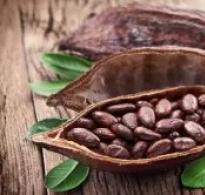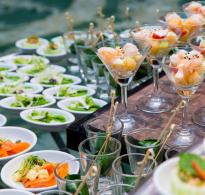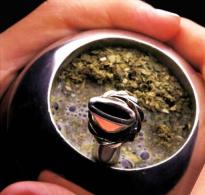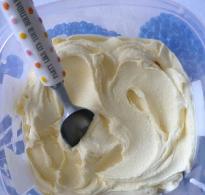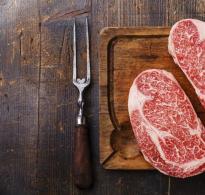How chocolate is made. Museum of concern "Babaevsky"
Many people know what chocolate is made from: cocoa beans and cocoa butter. Chocolate can be called the most popular sweet among both children and adults. It contains substances that affect the emotional state of a person, namely: the feeling of joy and love.
You need to figure out what chocolate is made from. This is a confectionery product that is prepared on the basis of cocoa beans, or to be more precise, their oils.
It is obtained by processing beans. They are peeled and fried, as a result of which the fruits acquire a dark brown color. Three main components are obtained from them: grated cocoa, butter and cake. Chocolate products are made from a combination of powdered sugar, grated cocoa and butter, and cocoa powder is prepared from cake.
Cocoa beans are loaded with caffeine and theobromine and are naturally tart in taste. And the chocolate itself in most cases contains various aromatic additives. These include vanillin, mint oil, coffee, cognac, in some recipes alcohol and hot pepper are added. The filling can also be different, for example, nuts, candied fruits, raisins, waffles and even pieces of roasted cocoa beans are added to chocolate products.
How chocolate is made
 The production process is divided into several stages or technological stages, namely:
The production process is divided into several stages or technological stages, namely:
- Processing of cocoa beans with further separation into individual ingredients such as cocoa liquor, butter and dry residues.
- Grated cocoa is subjected to heat treatment at a temperature of 100˚C, after which it is pressed.
- After mixing grated cocoa, cocoa butter and sugar, a chocolate mass or technical chocolate is obtained, which is further crushed into crumbs: the smaller the pieces, the tastier and more tender the chocolate product will be.
- The most important step is the tempering of the chocolate mass. This means that the heated mass is cooled and then heated again. This procedure is necessary to give shine to the chocolate product.
- Further, various flavors and fillers are added to the chocolate mass, and then confectionery products are formed by pouring the mass into special molds.
- After cooling, the stage of packaging the finished product begins.
Composition of modern chocolate
When buying a chocolate treat, you need to consider what the chocolate is made of. Today, factories offer a wide range of such a product, but often we get a sweet bar instead of chocolate. Unscrupulous manufacturers add not only the necessary components to the product, but also vegetable fats and soy. In this case, not a pure product is obtained, but a chocolate bar that does not contain the necessary concentration of useful substances.
High-quality chocolate must melt at a temperature equal to that of the human body, which is why it melts so well in the mouth.
 Bad chocolate will not melt like that, because unnecessary impurities and fats slow down this process.
Bad chocolate will not melt like that, because unnecessary impurities and fats slow down this process.
You should pay special attention to what chocolate is made of, and specifically to the percentage of cocoa beans and additives in the finished product. For example, dessert or semi-bitter chocolate must have at least 50% cocoa powder, bitter must contain 60% or more, and milk must not exceed the 30% barrier. The amount of sugar added depends on the type of chocolate. The classic composition includes:
- proteins: 5 to 8%;
- fats: 30 to 40%;
- carbohydrates: 5 to 6%;
- alkaloids: not more than 0.5%;
- mineral and tannins: no more than 1%.
All confectionery factories produce chocolate depending on the category of consumers. After all, what is allowed for adults is not necessarily allowed for children. For example, chocolate is prepared for babies with the addition of a significant amount of dairy products and with a lower percentage of grated cocoa. And there are also special sweets with vitamin supplements.
In order to expand the range of products, chocolate is produced in various forms, namely:
- in the form of a monolithic or porous tile;
- in the form of a monolithic or porous bar with various fillings and without them;
- in the form of accessories, medals, coins and various figurines, such as animals, cars, and so on;
- in the form of jewelry or semi-finished products, with the help of which it is possible to make all kinds of confectionery.
Variety of chocolate
 To date, several types of chocolate are known, which are made with the addition of various components, such as cocoa beans, lecithin, palm or cocoa butter, as well as various flavors and fillings. The main types of chocolate are:
To date, several types of chocolate are known, which are made with the addition of various components, such as cocoa beans, lecithin, palm or cocoa butter, as well as various flavors and fillings. The main types of chocolate are:
- Milky in appearance is lighter than, and sweeter in taste. It is prepared with the addition of dry ingredients, namely milk and cream;
- Bitter can contain up to 90% beans. This cocoa content gives chocolate a bitter taste, but the addition of a certain amount of sugar helps to smooth it out. This type of chocolate is considered the most useful.
- White or cream chocolate does not contain cocoa beans, only their oil. It is prepared with the addition of milk powder, sugar and vanillin.
- is made using special technologies: this means placing filled molds with chocolate mixture in vacuum boilers, which contribute to the appearance of air bubbles.
- Chocolate for diabetics contains sugar substitutes, namely: sorbitol, xylitol and others.
- Powdered chocolate can be both dessert and regular. It is made from grated beans and powdered sugar, and dry ingredients such as milk powder and cream may be present. The main difference between dessert and regular powder is the concentration of sugar.
The effect of chocolate on the human body
 The composition of chocolate has a positive effect on the performance and mental activity of the human brain. It helps the body cope with various stresses, both emotional and physical, and helps to alleviate feelings of anxiety and excitement. Even in Soviet times, in the departments of cardiology, patients were prescribed dark chocolate in certain doses. Since it prevents various cardiovascular diseases and helps with pressure and the occurrence of blood clots in the arteries.
The composition of chocolate has a positive effect on the performance and mental activity of the human brain. It helps the body cope with various stresses, both emotional and physical, and helps to alleviate feelings of anxiety and excitement. Even in Soviet times, in the departments of cardiology, patients were prescribed dark chocolate in certain doses. Since it prevents various cardiovascular diseases and helps with pressure and the occurrence of blood clots in the arteries.
Along with useful qualities, there are also negative aspects, for example, with unlimited consumption of chocolate, the risk of diseases such as obesity or diabetes increases. Such problems also arise due to the fact that manufacturers, trying to make huge profits, add various substances to products that adversely affect the human body.
To avoid such consequences, it is necessary to buy sweets only after making sure of their quality. Pay attention to the surface of chocolate: it should be shiny, and if the product has additives such as raisins or nuts, then it should be matte. The consistency should be firm and without visible deformations, pleasant in taste and smell. Chocolate without filling and additives should be stored for no more than six months, and with additives - no more than three. White is considered a perishable product compared to other types, since its shelf life should not exceed one month.
How to properly store chocolate
When purchasing such sweetness, it is necessary to pay attention to the date of production. It is strictly forbidden to eat expired chocolate, as its beneficial properties die.
Better in a cool and dark place, but this does not mean at all that it should be kept in the refrigerator. At sub-zero temperatures, condensation forms on the surface of the chocolate product, as a result of which the chocolate becomes covered with light spots and loses its taste characteristics. The optimum storage temperature is from +3 to +18˚С, and the humidity should not exceed 75%. Chocolate products should not be exposed to ultraviolet radiation and should not lie unpacked for a long time.
This leads to the appearance of grease stains on the surface of the chocolate, which can become the basis for the appearance of various types of fungus and mold. Shelving is the ideal place for storage.
Chocolate
For the first time, the inhabitants of the ancient civilization of the Olmec culture in South America learned about the possibility of making chocolate from cocoa beans. One man, going hunting in the jungle, randomly found amazing beans that struck him with a pleasant taste and aroma. Since then, the seeds of the cocoa tree have been used in the creation of various drinks and sweets for the upper class people and ritual offerings to the gods.
Around 1530, Hernán Cortés returned from South America to Europe and brought cocoa beans with chocolate with him. The Europeans liked the new delicacy, and chocolate began to be produced in confectionery shops.
Since that time, cocoa beans have become such a value that they even paid with these grains instead of money.
Cocoa beans have been discovered in South America
The recipe has changed and improved, but the basic principle of making chocolate has remained the same to this day. Today, most of the chocolate products are made in confectionery factories, so lovers of sweets are offered a large selection of chocolate products. Enjoying the taste of sweets, the question arises: how is chocolate made?
: The cocoa tree has the scientific name "Theobroma cacao", which means "food of the gods".
Preparation of cocoa beans
 factory chocolate
factory chocolate For the production of chocolate in a factory or at home, it is recommended to use only high quality ingredients. Any change in the composition or technological process can lead to a deterioration in taste. Factory chocolate must meet high standards and satisfy the desires of consumers as much as possible. Therefore, for the production of chocolate, enterprises purchase high-quality ingredients from suppliers.
Related materials:
How are lollipops made?
There are several types of chocolate:
- regular - the content of cocoa products from 35% to 55-60%;
- special chocolate - diabetic and for the military;
- dessert - with additives;
- with stuffing;
- porous;
- bitter;
- white.
 Peeled cocoa beans are crushed in special plants
Peeled cocoa beans are crushed in special plants Initially, high quality raw materials and prescription fillers are selected. On special installations under the control of the operator, the beans are cleaned of debris, cocoa shells and contaminants. With the help of crushing devices, the kernels are crushed and sent along the conveyor belt for roasting in an electric oven. Roasted crushed bean kernels are passed through a sieve with holes of different diameters and sorted according to the required size. Large particles are used to make bar chocolate, and small ones are added to the fillings.
There are the following fillings for chocolate:
- fruit and marmalade;
- fondant chocolate;
- fondant-creamy;
- praline;
- liqueur.
Interesting fact: Chocolate first appeared in Russia in 1786 thanks to the traveler Francisco de Miranda.
Cooking cocoa
 Cocoa beans are ground into powder
Cocoa beans are ground into powder
Cocoa bean particles are sent to special grinding plants, in which they turn into a fine powder, similar to flour. Confectioners try to achieve maximum grinding, because the smaller the particles, the better the taste of the chocolate.
Preparation of chocolate mass
Preparation of cocoa powder
 Rolling chocolate mass
Rolling chocolate mass The powder is poured into a special container at a temperature above + 40 ° C, so that it begins to release oil and take on a creamy consistency. The finished mass is transferred to the rolling apparatus, in which it is subjected to mixing and additional grinding under the pressure of the rollers. As a result, the plastic mass becomes clumpy and loose.
Related materials:
How are candies made?
Distribution of chocolate mass
 Conching chocolate mass
Conching chocolate mass Powdered sugar and additional additives are added to cocoa powder according to the recipe. As a result, the amount of cocoa butter should be in the range of 32-36%. If there is not enough butter in grated cocoa, then it is added until the desired consistency is obtained.
At this stage, various additives are used to make chocolate, for example: dairy products, nut kernels, vanillin, milk, raisins.
Interesting fact: The first chocolate market in Russia was created by Alexei Ivanovich Abrikosov in 1880 with the name "A. I. Abrikosov's Sons Association".
Conching
Once the ingredients are added to the chocolate mixture, the operator sends it to the conching machine. In a special open container, mixing takes place in a heated state for up to 72 hours. Prolonged contact with air and constant stirring, allows you to weather the mixture of unpleasantly smelling and tannins and thereby improve the quality and taste of future products.
Shaping chocolate
 Chocolate mass is poured into special molds
Chocolate mass is poured into special molds The finished mass is sent to the apparatus for the formation of chocolate bars. The molten mass with a temperature of +40-45°C is carefully cast into prepared molds, where it is quickly cooled to +33°C and held for 30-40 minutes. With the help of a vibratory conveyor, air bubbles are removed from the semi-cooled chocolate bars. This is necessary so that the cocoa butter in the molds crystallizes and the chocolate then melts in the mouth, creating a pleasant sensation.
































 First, we went up to the workshop, where cocoa beans are sorted on special equipment, sent to the roasting department by a conveyor, then roasted and cooled. I tried "on the tooth" one such fried "nut". Terribly tasteless and bitter. Until you get the taste of your favorite chocolate!
First, we went up to the workshop, where cocoa beans are sorted on special equipment, sent to the roasting department by a conveyor, then roasted and cooled. I tried "on the tooth" one such fried "nut". Terribly tasteless and bitter. Until you get the taste of your favorite chocolate! Cocoa nibs - dry and fragrant - move to the next installation: two massive disks with protruding "fingers" rotate at great speed in different directions, spinning bean grains in their frantic dance. And - a miracle! - at the exit from the installation, cocoa no longer pours, but ... flows. Krupka turned into a mushy flowing mass! It turns out that each bean contains more than half of the cocoa butter. Rubbing dry grains between the rotating fingers of the disks, the installation releases oil, which changes the consistency of the supplied mass. After all, liquid cocoa mass, as it is now called, is more convenient for pumping to the next workshop, where chocolate masses are prepared.
Cocoa nibs - dry and fragrant - move to the next installation: two massive disks with protruding "fingers" rotate at great speed in different directions, spinning bean grains in their frantic dance. And - a miracle! - at the exit from the installation, cocoa no longer pours, but ... flows. Krupka turned into a mushy flowing mass! It turns out that each bean contains more than half of the cocoa butter. Rubbing dry grains between the rotating fingers of the disks, the installation releases oil, which changes the consistency of the supplied mass. After all, liquid cocoa mass, as it is now called, is more convenient for pumping to the next workshop, where chocolate masses are prepared. The recipe of all chocolates without exception includes cocoa mass, cocoa butter and powdered sugar. The main thing is to mix them together in certain proportions.
The recipe of all chocolates without exception includes cocoa mass, cocoa butter and powdered sugar. The main thing is to mix them together in certain proportions. - I personally especially love our branded "Babaevsky" chocolate, - says Margarita Mikhailovna. - Cognac and tea extract are also added to it, which gives a special touch to the taste. But in the "Children's" no additional components are placed.
- I personally especially love our branded "Babaevsky" chocolate, - says Margarita Mikhailovna. - Cognac and tea extract are also added to it, which gives a special touch to the taste. But in the "Children's" no additional components are placed. The mixed mass - it's already almost chocolate, only liquid and hot - is pumped to the next workshop for casting, where large and small, with and without filling, bitter and sweet, figured and flat chocolates are obtained on a tile machine. Here, it turns out, what a long way cocoa beans go before they fall from the chocolate tree into our hands and melt in our mouths. But how beautiful it is! And delicious!
The mixed mass - it's already almost chocolate, only liquid and hot - is pumped to the next workshop for casting, where large and small, with and without filling, bitter and sweet, figured and flat chocolates are obtained on a tile machine. Here, it turns out, what a long way cocoa beans go before they fall from the chocolate tree into our hands and melt in our mouths. But how beautiful it is! And delicious!  Before entering the factory, inhaling the bitter aroma and swallowing my saliva, I dreamed about how I would try all the varieties, evaluate the taste at each stage of preparation. But, as you now understand, in the process of work it is not very possible to taste: around the machines, cars, everything is spinning and spinning. And as the pleasure was delayed, the appetite grew more and more. But when the long-awaited moment of sampling finally arrived, it turned out that chocolate is not food after all. Each variety is a unique, often gourmet delicacy that is not eaten - that is enjoyed.
Before entering the factory, inhaling the bitter aroma and swallowing my saliva, I dreamed about how I would try all the varieties, evaluate the taste at each stage of preparation. But, as you now understand, in the process of work it is not very possible to taste: around the machines, cars, everything is spinning and spinning. And as the pleasure was delayed, the appetite grew more and more. But when the long-awaited moment of sampling finally arrived, it turned out that chocolate is not food after all. Each variety is a unique, often gourmet delicacy that is not eaten - that is enjoyed. 

